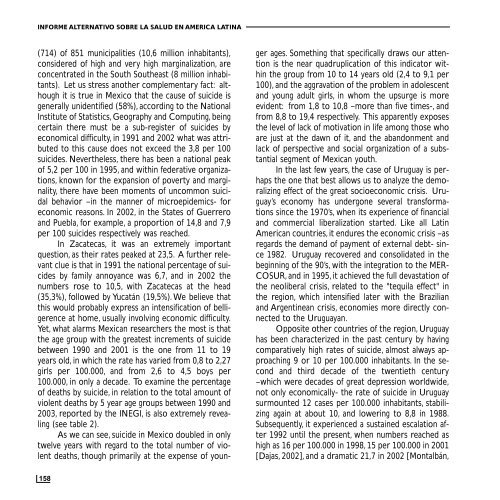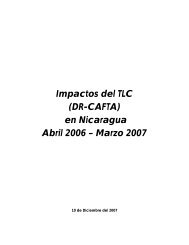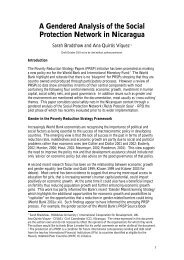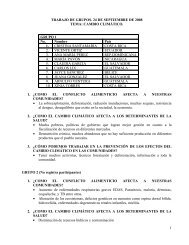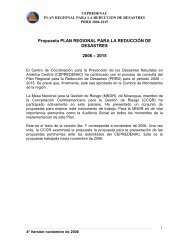Download - CISAS | Centro de Información y Servicios de AsesorÃa ...
Download - CISAS | Centro de Información y Servicios de AsesorÃa ...
Download - CISAS | Centro de Información y Servicios de AsesorÃa ...
You also want an ePaper? Increase the reach of your titles
YUMPU automatically turns print PDFs into web optimized ePapers that Google loves.
INFORME ALTERNATIVO SOBRE LA SALUD EN AMERICA LATINA(714) of 851 municipalities (10,6 million inhabitants),consi<strong>de</strong>red of high and very high marginalization, areconcentrated in the South Southeast (8 million inhabitants).Let us stress another complementary fact: althoughit is true in Mexico that the cause of suici<strong>de</strong> isgenerally uni<strong>de</strong>ntified (58%), according to the NationalInstitute of Statistics, Geography and Computing, beingcertain there must be a sub-register of suici<strong>de</strong>s byeconomical difficulty, in 1991 and 2002 what was attributedto this cause does not exceed the 3,8 per 100suici<strong>de</strong>s. Nevertheless, there has been a national peakof 5,2 per 100 in 1995, and within fe<strong>de</strong>rative organizations,known for the expansion of poverty and marginality,there have been moments of uncommon suicidalbehavior –in the manner of microepi<strong>de</strong>mics- foreconomic reasons. In 2002, in the States of Guerreroand Puebla, for example, a proportion of 14,8 and 7,9per 100 suici<strong>de</strong>s respectively was reached.In Zacatecas, it was an extremely importantquestion, as their rates peaked at 23,5. A further relevantclue is that in 1991 the national percentage of suici<strong>de</strong>sby family annoyance was 6,7, and in 2002 thenumbers rose to 10,5, with Zacatecas at the head(35,3%), followed by Yucatán (19,5%). We believe thatthis would probably express an intensification of belligerenceat home, usually involving economic difficulty.Yet, what alarms Mexican researchers the most is thatthe age group with the greatest increments of suici<strong>de</strong>between 1990 and 2001 is the one from 11 to 19years old, in which the rate has varied from 0,8 to 2,27girls per 100.000, and from 2,6 to 4,5 boys per100.000, in only a <strong>de</strong>ca<strong>de</strong>. To examine the percentageof <strong>de</strong>aths by suici<strong>de</strong>, in relation to the total amount ofviolent <strong>de</strong>aths by 5 year age groups between 1990 and2003, reported by the INEGI, is also extremely revealing(see table 2).As we can see, suici<strong>de</strong> in Mexico doubled in onlytwelve years with regard to the total number of violent<strong>de</strong>aths, though primarily at the expense of youngerages. Something that specifically draws our attentionis the near quadruplication of this indicator withinthe group from 10 to 14 years old (2,4 to 9,1 per100), and the aggravation of the problem in adolescentand young adult girls, in whom the upsurge is moreevi<strong>de</strong>nt: from 1,8 to 10,8 –more than five times-, andfrom 8,8 to 19,4 respectively. This apparently exposesthe level of lack of motivation in life among those whoare just at the dawn of it, and the abandonment andlack of perspective and social organization of a substantialsegment of Mexican youth.In the last few years, the case of Uruguay is perhapsthe one that best allows us to analyze the <strong>de</strong>moralizingeffect of the great socioeconomic crisis. Uruguay’seconomy has un<strong>de</strong>rgone several transformationssince the 1970’s, when its experience of financialand commercial liberalization started. Like all LatinAmerican countries, it endures the economic crisis –asregards the <strong>de</strong>mand of payment of external <strong>de</strong>bt- since1982. Uruguay recovered and consolidated in thebeginning of the 90’s, with the integration to the MER-COSUR, and in 1995, it achieved the full <strong>de</strong>vastation ofthe neoliberal crisis, related to the "tequila effect" inthe region, which intensified later with the Brazilianand Argentinean crisis, economies more directly connectedto the Uruguayan.Opposite other countries of the region, Uruguayhas been characterized in the past century by havingcomparatively high rates of suici<strong>de</strong>, almost always approaching9 or 10 per 100.000 inhabitants. In the secondand third <strong>de</strong>ca<strong>de</strong> of the twentieth century–which were <strong>de</strong>ca<strong>de</strong>s of great <strong>de</strong>pression worldwi<strong>de</strong>,not only economically- the rate of suici<strong>de</strong> in Uruguaysurmounted 12 cases per 100.000 inhabitants, stabilizingagain at about 10, and lowering to 8,8 in 1988.Subsequently, it experienced a sustained escalation after1992 until the present, when numbers reached ashigh as 16 per 100.000 in 1998, 15 per 100.000 in 2001[Dajas, 2002], and a dramatic 21,7 in 2002 [Montalbán,158


